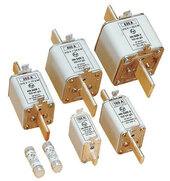Have you looked at the specs? Interrupt is similar to Class T, but I'm not certain how the Class J is constructed. According to what I have seen, the Class J has a time delay. That may be too long with a very large current flowing.
Mostly I'm giving you the gears.
There are 3 or 4 different types of J fuse you can get that range form time delay to fast for protecting drives with large currents and high available faults....
Why I bring this up....
I remember these big exide battery chargers I used to fix I think they were 300 or 400 amps.
Diodes as big as beer can ( well close )
Some used a T some had J installed.
We used them relatively interchangeably on those chargers ( to be very specific ).
J was rated for 600 volt T I don't think it was rated above 250 or 400 volts dc or something
My point is its a stoutly build fuse with a lot of interrupt capacity and the ability to deal with the heat of clearing a fault
These are some fuses I used on the K 1050E Kiruna both in the main converter and chopper drives ( one fed form a trolley line one a large battery bank to a DC drive and traction motor )

Even has a little striker in it to indicate its blown ( a common feature in an industrial fuse )
Those are god dam expensive, a good fuse is not a cheap thing....
In a previous post in this thread I saw some stuff like this.

I've seen this on light vehicles and they do not inspire much confidence in me.
I helped a mechanic make a fuse holder for one of these a couple of weeks ago actually, for a solar system and I did not give it much thought because, its not my cottage.
Now back to those Exide chargers.
I made some fuse holders for them too to convert them from T to J
I made it out of nice thick piece of glasstic stand off from a Silvania motor starter switch with some red brass bolts .
Never had a problem...
But those light duty fuses I see like the one above is really light duty looking.
I'm not going to say you should pick one fuse over another since T seems to be the standard but I am going to say use a good semi conductor fast acting fuse and a decent stout holder to contain and arcs or burn through.
Fusing is not a place to cut corners.
Aliexpress and Ebay are full of cheap Chinese fuses and fake parts too.
Just because something says it a certain thing you should question if its Chinese and a really good price.
No I did not get the T to J conversion blessed by an engineer.
I just did it because we were short of T fuses at one point and I know the J would work and no one was looking over my shoulder.
I did talk to some guys up in engineering years later over coffee and they were not impressed.
I'm going to go talk to that mechanic and see if I can talk him out of what he was going to do.
And making something out of something handy.
Might use a J fuse lots of them around... Ahem.
( Added later after reading some others posts... I might find some old stock T fuses in the car barn where the last electric Loco was used the spares cabinet... might still be there, might be a battery charger of some sort with fuse holders I can strip.... I'm going to heed the advice myself and look for T, although I think the fast J is probably fine )
But a proper fuse and holder are a major safety concern.
Don't anyone listen to anything I say!
Its all 100 percent opinion form some guy on the interweb with both an opinion and anal sphincter everyone has at least one of those.




